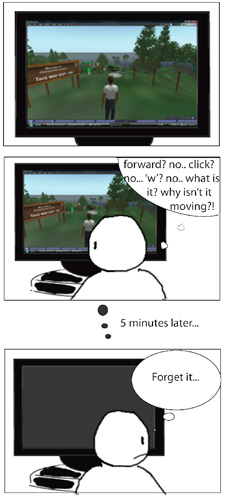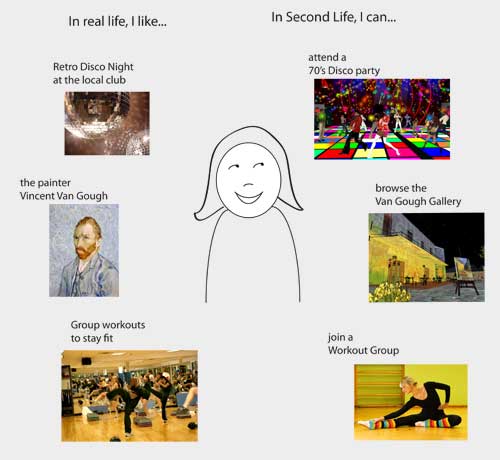
From our research phase, we applied proven Human-Computer Interaction methods to identify the following trends in Second Life:
- New users are initially confused by the search feature interface and have trouble finding groups and events
- New users do not comprehend the nature and variety of the content available in Second Life
- New users want to meet new people
- Experienced Residents distrust the search feature and rely on group notices and word of mouth to find new places and events
- Experienced Residents miss being able to leave feedback about their Second Lives
- Experienced users are willing to embrace change it it benefits them
Personas

Personas allow the key features from a user population to be extracted and concentrated onto one user. A persona gives a "face" to a user group, allowing us to design for specific personalities instead of trying to design for vaguely defined group characteristics. We created five personas to cover a range of user expertise:
- Sean (the curious) is a 22 year old graduate student and has been using Second Life for one week. He started using Second Life because of all the media attention it's received. He is still getting used to the user interface, has no contacts in Second Life, and is unaware of the social norms
- Kelly (the invitee) is a 24 year old waitress and has been using Second Life for two weeks. She was invited to join Second Life by her old friend Nicole. Kelly is still awkward with the user interface, but has the basic interaction down. She has some friends via her real life friend Nicole, who has given her pointers on social norms, but she's not yet acclimated to Second Life's social atmosphere.
- Jim (the company man) is a 33 year old consultant and has been using Second Life for three months. He started using Second Life because of company meetings in-world. Jim has learned the main functions of the user interface and ways to interact with the world. He is comfortable amongst colleagues and at company events, but he is still learning behavioral norms of Second Life
- Andrew (the go-to guy) is a 35 year old councilor and has been using Second Life for 1.2 years. He enjoys collaborating on building projects with other Residents and helping newer Residents make Linden Dollars. Andrew is very comfortable with the user interface, and is skilled in building. He is fully acclimated to the social scene of Second Life, and is a member of multiple groups in-world
- Julie (the professional) is a 38 year old singer/housewife and has been using Second Life for 2 years. She regularly holds concerts in Second Life and enjoys building strong bonds with her fans.Julie is not a technical expert in Second Life, but she is able to set herself up for concerts, and has basic building skills. Julie has many friends and fans in Second Life. She shares her real life information and likes to help fans connect to one another.
- Sean is having trouble moving his avatar in Second Life. Not knowing that this is because Second Life has frozen, Sean becomes frustrated and discouraged.
- Sean is greeted by a strange-looking avatar. Not yet acquainted with the fact that Second Life avatars can look like anything, Sean decides to get away from the stranger.
- Kelly goes in-world while her friend Nicole is not on. She asks a group of Residents for help, but receives no response. Not knowing that those Residents were "campers", Kelly becomes discouraged and wonders whether asking strangers for help was not worthwhile
- Kelly decides to surprise her friend Nicole by taking her to a new event. However, search results that came up don't seem to relate much to what Kelly typed in. Kelly becomes confused.
- Jim just finished a meeting in Second Life, and wants to see if his any of his old college friends are also in Second Life. Jim goes to the "People" tab of the search feature and types in a friend's name. Not knowing that searches only use a Resident's username, Jim tries to find several old friends unsuccessfully. Jim is discouraged and gives up
- Julie has a concert scheduled tonight, but it conflicts with her son's soccer game. She tries to look for her manager and the venue owner to cancel the event. Neither her manager nor the venue owner were online ,and she sends them messages in-world, hoping they would see it in time. After four hours, Julie has not received any responses, so she has no choice but to hold the concert and miss her son's soccer game. Julie wished that there was a way out of Second Life to contact her manager and the venue owner in situations like this.
- Andrew had always advertised the items he has built for sale on his website. He decides to try out Second Life's classified ads to promote his objects. There is a minimum fee of 50L$ for an advertisement. Since Andrew is only trying the system out, he decides to pay the minimum. After submitting the ad, andrew checks the listings to find that he is a the bottom of the list, while a builder who produces objects of lesser quality is at the top of the list, simply because the other builder has paid 2000L$ for the ad. After a week, Andrew gets no visitors through the ad, he decides not to continue using the classifieds.
- Sean is waiting for Second Life to render, and is presented with the Regional Information box. He sees a treasure hunting event and decides to attend it. Through the event, Sean meets new people and begins to become more comfortable with the Residents in Second Life
- Kelly decides to invite her friend Nicole shopping. When Kelly opens the search feature, she is prompted for her interests, so she enters "square dancing" as an interest. After doing so, Kelly is estatic to find that "Country Wester Warehouse" is recommended to her. She decides to take Nicole shopping there.
- Jim is interested in expanding his connections on Second Life. He does a search for consultant groups and looks at the group information, such as mutual friends, matched interests, and upcoming events. It looks like a good fit and Jim joins the group.
- Julie is reminded by Second Life that her friend is holding a concert at 8pm. Julie really enjoys herself at the concert and gives a positive rating to the concert to show her appreciation
- Andrew decides to try the classified feature on Second Life, and he decides to pay the minimum of 50L$ for this ad. Andrew finds his ad at the bttom of the list but with a positive rating. At the top of the list ,he recognizes an ad from a less skilled builder who paid 2000L$ for the ad, but has a negative rating. Andrew checks his ad at the end of the week to find he has 20 hits! It seems that with a positive rating, his low position didn't matter too much. He decides to auto-renew the ad.
Need Scenarios
From the personas, we created seven need scenarios, each of which focus on a specific breakdown in a user's experience with Second Life. These scenarios were validated with Second Life users to confirm our correct understanding of problems that need to be solved. The scenarios are:

Vision

After validating the needs of users, we brainstormed five different visions of systems that satisfy the aforementioned needs. By consolidating the strengths of each of the five visions, we constructed a single combined vision for a system that enriches the new user's experience. This system should present dynamic content to the user as Recommendations in the user interface and as Regional Information, such as upcoming events, as they enter a Place. These features decrease the mental load in looking for interesting things in Second Life for the user. Tailing recommendations to each user's specific interests increases the chance of those recommendations being attractive to the user. A rating system allows users to contribute to the community and improve their own experience. When users rate, they are refining their own recommendations and helping new areas in Second Life. It also helps retain new users by introducing them to the possibilities within Second Life and connecting them to the community.
Concept Scenarios
Based on the combined vision, we revisited our personas and created scenarios of how this system can help each persona achieve his or her goals in Second Life:

From Ideas of Designs
We validated both the need and the concept scenarios with Second Life users and received positive feedback. In designing the system, we were guided by our final vision, and constantly checked back our concept scenarios to ensure that our design solves the problems we have set out.